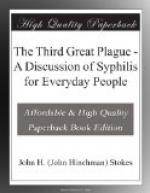Although syphilis sprang upon the world from ambush, so to speak, it did the world one great service—it aroused Medicine from the sleep of the Middle Ages. Many of the greatest names in the history of the art are inseparably associated with the progress of our knowledge of this disease. As Pusey points out, it required the force of something wholly unprecedented to take men away from tradition and the old stock in trade of ideas and formulas, and to make them grasp new things. Syphilis was the new thing of the time in the sixteenth century and the study which it received went far toward putting us today in a position to control it. Before the beginning of the twentieth century almost all that ordinary observation of the diseased person could teach us was known of syphilis. It needed only laboratory study, such as has been given it during the past fifteen years, to put us where we could appeal to every intelligent man and woman to enlist in a brilliantly promising campaign. For a time syphilis was confused with gonorrhea, and there could be no better proof of the need for separating the two in our minds today than to study the way in which this confusion set back progress in our knowledge of syphilis. John Hunter, who fathered the idea of the identity of the two diseases, sacrificed his life to his idea indirectly. Ricord, a Frenchman, whose name deserves to be immortal, set Hunter’s error right, and as the father of modern knowledge of syphilis, prepared us for the revolutionary advances of the last ten years.
There is something awe-inspiring in the quiet way in which one great victory has succeeded another in the battle against syphilis in the last decade. If we are out of the current of these things, in the office or the store, or in the field of industry and business, announcements from the great laboratories of the world seldom reach us, and when they do, they have an impractical sound, an unreality for us. So one hears, as if in a speaking-tube from a long distance, the words that Schaudinn and Hoffmann, on April 19, 1905, discovered the germ that causes syphilis, not realizing that the fact contained in those few brief words can alter the undercurrent of human history, and may, within the lives of our children and our children’s children, remake the destiny of man on the earth. A great spirit lives in the work of men like Metchnikoff and Roux and Maisonneuve, who made possible the prophylaxis of syphilis, in that of Bordet and Wassermann, who devised the remarkable blood test for the disease, and in that of Ehrlich and Hata, who built up by a combination of chemical and biological reasoning, salvarsan, one of the most powerful weapons in existence against it. Ehrlich conceived the whole make-up and properties of salvarsan when most of us find it a hardship to pronounce its name. Schaudinn saw with the ordinary lenses of the microscope in the living, moving germ, what dozens can scarcely see today with the germ glued to the spot and with all the aid of stains and dark-field apparatus. After all, it is brain-power focused to a point that moves events, and to the immensity of that power the history of our growing knowledge of syphilis bears the richest testimony.




